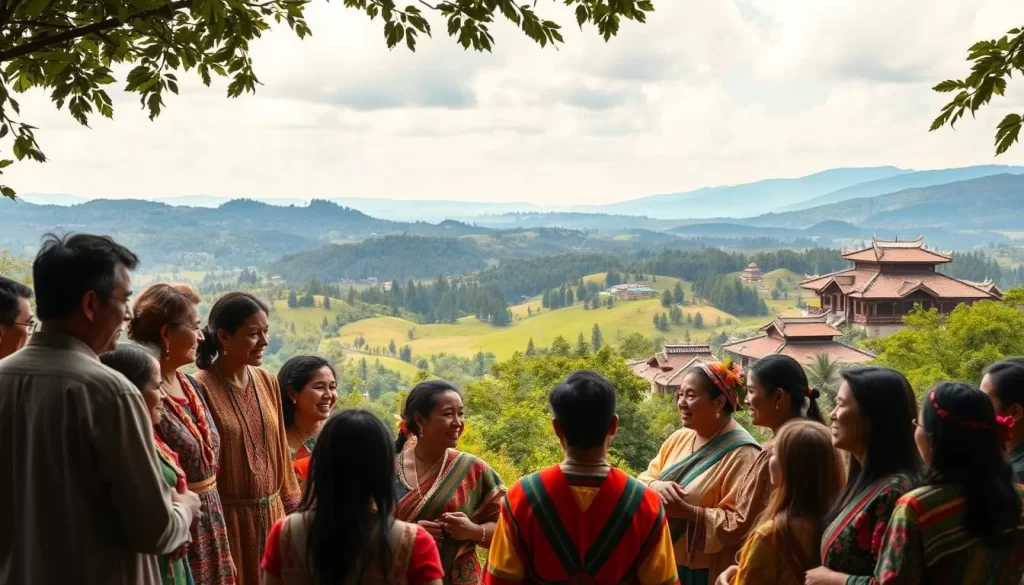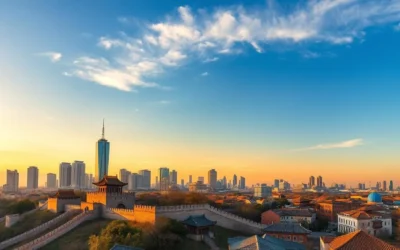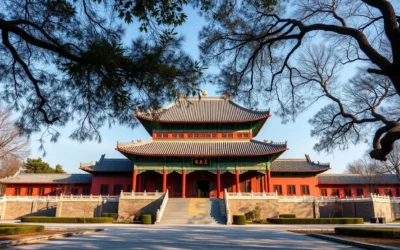✓ Accommodations ✓ Flights ✓ Rental Cars
Welcome to a journey through the fascinating world of language in a culturally rich area. This region is a melting pot of dialects and traditions, offering a unique glimpse into its heritage. Here, Standard Mandarin serves as the official language, connecting millions of people across the country.
Beyond Mandarin, you’ll discover a variety of local dialects that add depth to the region’s identity. Minority languages also play a significant role, enriching the cultural landscape. With over 302 living languages spoken in the area, the diversity is truly remarkable.
Understanding these linguistic nuances helps you appreciate the region’s history and traditions. Whether you’re curious about Mandarin’s dominance or the charm of local dialects, this section sets the stage for an enlightening exploration. Let’s dive in and uncover the stories behind the words.
Understanding the Linguistic Landscape of China
Exploring the linguistic diversity of China reveals a rich tapestry of history and culture. Over centuries, the region has developed a complex web of languages and dialects, each with its own story. From ancient scripts to modern speech, the evolution of these languages reflects the country’s dynamic past.
Historical Evolution of Chinese Languages
The roots of Chinese languages trace back to the Shang Dynasty (1600-1046 BCE), where early writing systems emerged. Over time, geographic isolation and political changes led to the development of distinct dialects. For example, Mandarin became the dominant language due to its use in government and education.
Regional differences also played a role. Areas like the Yangtze River Delta saw the rise of Wu, while Cantonese flourished in Guangdong. These dialects not only reflect local traditions but also highlight the influence of historical events on language evolution.
Major Language Families and Variants
China’s languages belong to several families, with Sino-Tibetan being the largest. This family includes Mandarin, Wu, and Cantonese, among others. Each group has unique phonetic and grammatical features, shaped by centuries of cultural development.
Here’s a breakdown of the major language groups and their prevalence:
| Language Group | Primary Region | Native Speakers (%) |
|---|---|---|
| Mandarin | Nationwide | 65.7 |
| Wu | Yangtze River Delta | 6.1 |
| Cantonese | Guangdong | 5.6 |
| Min | Fujian | 6.2 |
| Hakka | Guangdong, Jiangxi | 3.5 |
These groups showcase the diversity of language spoken across the region. Each variant carries its own cultural identity, making China’s linguistic landscape truly unique.

Understanding these language families helps you appreciate the depth of China’s cultural heritage. Whether you’re studying Mandarin or exploring local dialects, each variant offers a window into the country’s rich history.
Hebei Province, China: Official and widely spoken languages
Language plays a vital role in shaping the identity of any region. In this area, Mandarin Chinese serves as the official language, connecting people across the nation. However, local dialects add a unique flavor to the cultural landscape, reflecting centuries of tradition and history.

Mandarin Influence and Local Dialects
Mandarin’s dominance is evident in education, media, and government. Yet, local dialects thrive in everyday conversations, preserving regional heritage. For example, the Jin dialect is spoken by over 40 million people, including those in this region.
This coexistence creates a fascinating linguistic blend. While Mandarin unites the nation, dialects remind people of their roots. Families often pass down these speech patterns, ensuring their survival for generations.
Cultural Significance and Regional Identity
Dialects are more than just ways of speaking; they are markers of identity. They reflect the values, traditions, and history of a community. For instance, certain phrases or idioms in local dialects reveal unique cultural perspectives.
National language policies aim to standardize communication, but local practices resist homogenization. This interplay between unity and diversity enriches the region’s cultural fabric.
| Language | Primary Usage | Cultural Role |
|---|---|---|
| Mandarin | Official communication | National unity |
| Jin Dialect | Local conversations | Regional identity |
| Other Dialects | Community traditions | Cultural preservation |
Understanding this linguistic diversity helps you appreciate the region’s rich heritage. Whether you’re learning Mandarin or exploring local dialects, each language offers a window into the soul of the community.
The Role of Mandarin and Regional Dialects
Language connects people, cultures, and histories in ways that are both simple and profound. In this region, Mandarin Chinese serves as the unifying force, bridging diverse communities across the nation. Yet, regional dialects add a layer of richness, preserving local traditions and identities.

Mandarin as the National Lingua Franca
Mandarin is the most widely spoken language, with over 1.2 billion speakers globally. Its role as the national lingua franca ensures clear communication in education, media, and government. This uniformity fosters unity, especially in urban centers like Hong Kong, where diverse populations converge.
Despite its dominance, Mandarin coexists with vibrant regional dialects. These variants, such as Wu and Cantonese, are spoken by millions and reflect unique cultural identities. For example, the Jin dialect is used by over 63 million people, showcasing the linguistic diversity within the region.
Regional Dialects: Local Flavor and Identity
Dialects are more than just ways of speaking; they are markers of heritage. In rural provinces, local dialects thrive, passed down through generations. These speech patterns preserve traditions and offer a sense of belonging, even as Mandarin remains the primary language for official communication.
Urban areas, like Hong Kong, often blend Mandarin with local dialects. This mix creates a dynamic linguistic environment, where speakers navigate between formal and informal settings. Such flexibility highlights the adaptability of language in different contexts.
| Language | Primary Usage | Cultural Role |
|---|---|---|
| Mandarin | National communication | Unity and standardization |
| Wu Dialect | Eastern regions | Local identity |
| Cantonese | Southern areas | Cultural preservation |
Understanding this balance between Mandarin and dialects helps you appreciate the region’s linguistic richness. Whether you’re learning Mandarin or exploring local variants, each language offers a unique window into the culture and history of its speakers.
Minority Languages and Their Cultural Impact
The cultural mosaic of this region is deeply enriched by its minority languages, each carrying a unique heritage. These languages are not just tools for communication but also vital markers of identity and tradition. Over 300 distinct languages are spoken here, showcasing the incredible linguistic diversity.

Ethnic Groups and Unique Linguistic Heritage
Ethnic groups play a crucial role in preserving these languages. For example, the Uighur community uses a variant of the Arabic script, while the Zhuang, the largest minority group, has its own written system. These languages often carry ancient sounds and structures, offering a glimpse into the past.
State support has been instrumental in maintaining these languages. Bilingual education programs are increasingly implemented in regions with significant minority populations. Media representation, such as Tibetan and Uighur broadcasts, also helps keep these languages alive.
However, challenges remain. Urbanization and the global influence of English have led to a decline in the use of minority languages among younger generations. Efforts to revitalize endangered languages, like Tujia, are ongoing, but they require sustained commitment.
| Language | Ethnic Group | Region |
|---|---|---|
| Uighur | Uighur | Xinjiang |
| Zhuang | Zhuang | Guangxi |
| Tibetan | Tibetan | Tibet |
| Mongolian | Mongol | Inner Mongolia |
Minority languages contribute significantly to regional diversity and cultural identity. They remind us of the rich tapestry of traditions that make this region unique. By supporting these languages, we ensure that their heritage continues to thrive for generations to come.
Historical Context and Language Policies
The evolution of language policies in this region reflects a dynamic interplay between history, education, and cultural identity. Over the years, these policies have shaped how people communicate, learn, and preserve their heritage. Understanding this journey helps you appreciate the significance of language in shaping national unity and regional diversity.
Evolution of Language Legislation
Language legislation has undergone significant changes since the early 20th century. The Chinese Pinyin Act, approved in 1958, marked a turning point in standardizing Mandarin across the country. This act aimed to unify communication, making it easier for people from different regions to understand each other.
Historical moments, such as the Republic of China era, emphasized the use of “Guoyu” to promote a unified national identity. This term, meaning “national language,” was adopted to signify that Mandarin belonged to all ethnic groups, not just the Han majority. Over time, this approach helped bridge linguistic gaps and foster national cohesion.
Education, Migration, and Standardization
Education reforms have played a crucial role in promoting Mandarin. Schools across the country adopted standardized curricula, ensuring that students learned the national language. This effort not only improved literacy rates but also encouraged collaboration in workplaces and reduced migration costs.
Migration patterns further influenced language usage. As people moved across regions, they brought their dialects, enriching local cultures. However, the push for Mandarin as the lingua franca ensured that communication remained consistent, even in diverse communities.
“Language is the road map of a culture. It tells you where its people come from and where they are going.”
| Policy | Year | Impact |
|---|---|---|
| Chinese Pinyin Act | 1958 | Standardized Mandarin |
| Education Reforms | Post-1956 | Promoted Mandarin in schools |
| Migration Policies | 20th Century | Encouraged cross-regional communication |
Language policies have also shaped official documents and everyday writing. By standardizing terms and practices, these policies ensured clarity and consistency in both formal and informal settings. For more insights into how these policies continue to influence linguistic diversity, explore this detailed analysis.
Comparing Written and Spoken Language Variants
The written and spoken forms of Chinese reveal fascinating contrasts in structure and usage. While the written system relies on characters, spoken language varies widely across dialects. This duality creates a unique linguistic landscape, where the same written word can sound entirely different depending on the dialect.
Chinese Characters Versus Phonetic Systems
Chinese characters are a unifying force in writing, offering consistency across regions. However, spoken language uses phonetic systems that differ significantly. For example, the character for “water” (水) is pronounced “shuǐ” in Mandarin but “seoi” in Cantonese. These variations highlight the richness of Chinese dialects.
Vocabulary and word usage also differ between written and spoken forms. In writing, formal terms dominate, while spoken language often includes colloquial expressions. This difference reflects the adaptability of Chinese to various contexts.
| Aspect | Written Chinese | Spoken Dialects |
|---|---|---|
| Form | Uniform characters | Phonetic variations |
| Vocabulary | Formal terms | Colloquial expressions |
| Pronunciation | Standardized | Dialect-specific |
Meaning can shift due to phonetic differences. For instance, the word for “mother” (妈) is “mā” in Mandarin but “maa” in Cantonese. These subtle changes reflect the cultural nuances of each dialect group.
Despite these differences, writing acts as a unifying force. It bridges gaps between spoken dialects, ensuring mutual understanding. This balance between unity and diversity is a hallmark of Chinese language.
To explore more about the complexities of Chinese dialects, check out this comprehensive guide.
Modern Linguistic Trends in China
Globalization and technology are transforming the way we use and preserve languages. In today’s world, the Chinese language is not only a tool for communication but also a cultural export. Digital platforms are playing a key role in spreading its variety across the globe.
Technology is influencing how languages are taught and preserved. Apps and online courses make it easier for people to learn Mandarin and local dialects. These tools also help document endangered languages, ensuring they remain part of the cultural fabric.
There’s a renewed interest in preserving local dialects and minority languages. Initiatives focus on recording oral histories and creating educational materials. This effort highlights the importance of linguistic diversity in a rapidly modernizing country.
Technology’s Role in Language Preservation
Digital platforms are revolutionizing language learning. For example, apps like Duolingo and HelloChinese teach Mandarin to millions worldwide. These tools also introduce learners to regional varieties, such as Cantonese and Shanghainese.
Social media is another powerful tool. Platforms like WeChat and TikTok allow users to share content in their native dialects. This helps keep these languages alive, especially among younger generations.
Global Influence and Cultural Export
The Chinese language is gaining prominence on the global stage. Mandarin is now the second most studied language in the world, with over 400 million learners. This growth is driven by China’s economic influence and cultural outreach.
Cultural exports, like Chinese films and music, also play a part. These mediums showcase the richness of the language and its varieties, making them more accessible to a global audience.
Efforts to preserve and promote linguistic diversity are ongoing. For example, research in Baoding highlights the challenges and successes of language acquisition in diverse communities. These studies provide valuable insights into how languages evolve in a globalized world.
In conclusion, modern trends are reshaping the linguistic landscape. Technology, preservation efforts, and global influence are ensuring that the Chinese language and its dialects continue to thrive in the 21st century.
Conclusion
Linguistic diversity is a cornerstone of cultural identity, shaping communities across regions. With over 307 languages spoken, each group contributes to a vibrant tapestry of heritage. Mandarin, spoken by over 1.1 billion people, unites the population, while dialects like Wu and Cantonese preserve local traditions.
Modern trends, such as digital platforms, are reshaping how we learn and preserve these languages. For example, the Global Chinese Learning Platform has attracted millions of users worldwide. This blend of tradition and innovation ensures that every term and word remains part of the cultural fabric.
Exploring this linguistic richness offers a deeper understanding of history and identity. Whether you’re studying Mandarin or discovering regional dialects, each language tells a unique story. Dive into the fascinating world of Chinese linguistic diversity to uncover more.
The above is subject to change.
Check back often to TRAVEL.COM for the latest travel tips and deals.






